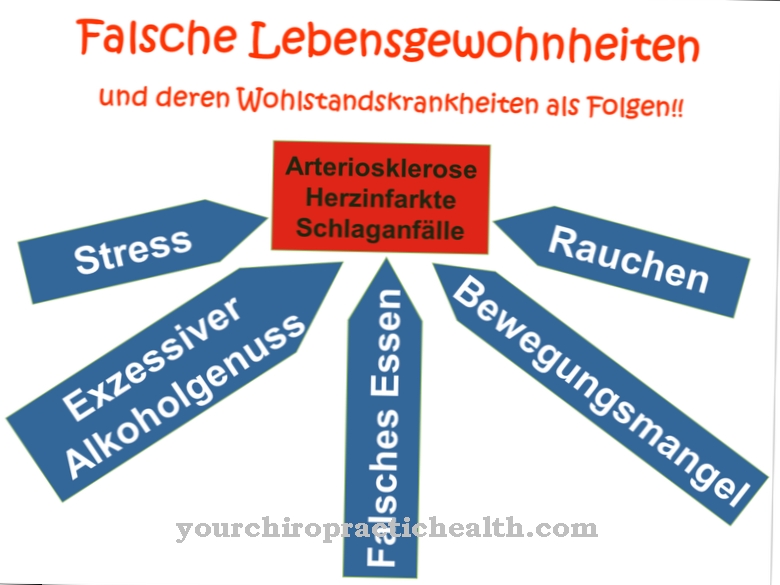A muscular torticollis or Torticollis muscularis is a congenital and acquired neurological disorder and is common in infants. Typically the head is tilted to one side. The torticollis comes about through the shortening of the nodding muscles. If not treated in time, aggravation and neurological problems threaten.
What is a muscular torticollis?
.jpg)
© magemasher - stock.adobe.com
In medicine, the term denotes muscular torticollis a rare, partly congenital, partly acquired misalignment of the head.
The congenital variant often occurs in infants and is noticeable in that the head is tilted towards the healthy side, accompanied by a shortening of the lateral nodding muscle.
The right side is affected in 75 percent of those with torticollis. Limited range of motion in the cervical spine makes it difficult for the patient to turn their head sideways and up and down. Further symptoms are neck pain, occasional knots and tension in the neck muscles, sensitivity of the cervical spine, head tremors, uneven shoulder heights and the resulting lack of mobility of the shoulder and arm muscles. In extreme cases, sensitivity problems and motor disorders in the upper extremity can occur.
causes
The causes for one muscular torticollis cannot be clearly clarified. A connective tissue change within the nodule muscle appears to be responsible, but where this change came from is not known. Whether the disease is caused by bleeding in the muscles, injuries or pressure in the muscles during childbirth remains to be clarified medically.
An unfavorable position in the uterus can lead to torticollis. This is also called a "nodding hematoma". The muscular torticollis often occurs together with other malformations such as hip dysplasias or club feet. An inheritance cannot yet be proven.
Other causes of a torticollis muscularis can include hearing loss, ametropia, balance disorders, malformations of the cervical spine or stiff neck due to drafts, which should not be confused with the torticollis muscularis.
Symptoms, ailments & signs
In the case of a muscular torticollis, the head is tilted to one side, in conjunction with a lateral rotation to the opposite shoulder and extension or flexion of the cervical spine. The type of muscular torticollis can be described depending on the positions of the head and neck: Laterocollis: The head is tilted towards the shoulder Rotational torticollis: the head rotates along the longitudinal axis Anterocollis: forward flexion of the head and neck Retrocollis: overstretching of the head and neck backwards
Often these bad postures occur in a combined form. A torticollis can be an independent disorder or a symptom of another clinical picture. The problem may be apparent immediately after birth or appear over the following weeks. Symptoms can vary widely, the most common of which are pain and immobility.
Diagnosis & course
The muscular torticollis the doctor recognizes the typical misalignment of the head. To make a reliable diagnosis, he first includes similar diseases such as B. malformations of the cervical spine or a hearing loss. X-rays of the cervical spine are also used for assessment. A hearing test is useful for babies.
If a muscular torticollis is not treated or not treated in time, permanent damage can occur, which leads to a functional impairment of the cervical spine and, due to the imbalance of stress, promote premature arthrosis of the cervical spine.
As a result, a scoliosis of the cervical spine forms due to the bony malalignment, which can a. Can cause facial asymmetries. These can no longer be completely corrected if the treatment is too late.
If therapy begins early enough and is carried out consistently, the muscular torticollis can be corrected well and possible movement restrictions can be prevented. Regular follow-up examinations are important afterwards. If therapy is not given in time, the muscular torticollis can no longer be completely regenerated.
Complications
Due to the torticollis, those affected suffer from a severe misalignment of the head. In most cases, this is also associated with severe pain and tension. It is not uncommon for the pain to spread to other regions of the body and can also lead to headaches or back pain.
There are also significant restrictions on movement and thus severe restrictions in the patient's everyday life, so that the quality of life is significantly reduced. The neck of the affected person is usually swollen from the torticollis. The symptoms of the torticollis can also have a negative effect on the hips.
This disease causes development disorders, especially in children, so that it is delayed. The torticollis can also have a negative effect on the hearing ability of the patient and limit it as well. Treatment is usually carried out with the help of surgical interventions and various therapies.
In many cases it is also necessary to attend physiotherapy. There are usually no complications. In most cases, the course of the disease is also positive. The torticollis does not affect the life expectancy of the patient.
When should you go to the doctor?
Persistent discomfort in the neck, headaches or permanent tension in the shoulders and neck should be referred to a doctor. If the head is tilted in both infants and adults, which cannot be regulated independently, the person concerned needs help. Sleep disturbances, changes in the appearance of the skin as well as concentration and memory deficits are considered unusual and should be examined by a doctor. A tremor of the head, a decrease in normal muscle strength in the arms and restricted mobility are signs of an existing disorder. If there is a formation of knots, an optical flaw due to uneven shoulder heights and complaints of the cervical spine, a doctor's consultation is necessary.
Pain, shoulder joint problems and internal weakness should be presented to a doctor. In the case of impaired vision, an increased risk of accidents and falls, as well as reduced participation in social life, there is a condition that should be treated by a doctor. If you can no longer take part in your daily duties or usual sporting activities, you should consult a doctor.
A doctor is also recommended if there are fluctuations in mood, general behavioral abnormalities, or changes in personality. If there is persistent depressive or aggressive behavior, a permanent loss of well-being or feelings such as shame, secondary diseases can develop if left untreated.
Treatment & Therapy
Timely treatment is of crucial importance for the course muscular torticollis. There are two different options:
1. Conservative treatment
2. Surgical treatment
Conservative treatment:
Conservative treatment can be carried out without a hospital stay. A correction of the misalignment is attempted with various measures:
- opposite positioning of the head
To correct the misalignment, the infant is gently offered attention stimuli in the opposite direction so that he has to turn his head in order to perceive them.
- Avoiding the prone position
It is very important to place the babies on their back or on their side. Prone position could exacerbate the problem.
- physiotherapy
Careful stretching exercises move the head in the opposite direction to achieve a healthy position. It is essential that parents regularly perform the exercises they have learned at home. In most cases, this eliminates the need for surgical correction if treated early.
Surgical treatment:
If conservative treatment does not produce sufficiently positive results or has started too late, surgical correction of the nodding muscle is sometimes unavoidable. This involves severing the neck muscle at the base of the sternum to correct the misalignment. The head must then be fixed with a neck tie or a plaster cast so that it can be immobilized for three to four weeks.
You can find your medication here
➔ Medicines for back painOutlook & forecast
The muscular torticollis generally has a good prognosis if conservative therapy is started in good time and is carried out consistently. In about 90 percent of the children affected, the torticollis can be corrected with professional physiotherapy and even without an operation. Even in the case of an early operation, the prognosis for those affected is very good. In most cases, the misalignment can be corrected without restricting movement. However, regular follow-up examinations are important in order to detect a possible recurrence in good time.
Without treatment, however, the malformation can no longer be completely corrected. If the muscular torticollis remains untreated or is treated too late, complications can also arise. Under certain circumstances, a functional limitation of the cervical spine can occur. An uneven load on the neck can also lead to joint osteoarthritis of the loaded cervical vertebrae. In addition, a bony malalignment of the cervical and thoracic spine can develop.
If left untreated, the skull on the affected side and the back of the head on the opposite side can visibly flatten out due to shifted pressure contact surfaces. The facial asymmetry becomes more noticeable as it grows. On the affected side, the face is relatively shortened, the ears and eyes are on different levels. These facial asymmetries are not always fully correctable in the late stages.
prevention
An active way to prevent the muscular torticollis there is not any. The problem can be caused by an unfavorable location in the uterus that cannot be influenced. Injuries from childbirth can also be triggers. The malposition can only be improved or completely corrected by the measures listed above.
Aftercare
Follow-up care depends on the development of the muscular torticollis. Follow-up care should begin early so that a deformity can be counteracted. As part of aftercare, exercise and sport alleviate and also have a preventive effect. Sports exercises with targeted stretches of the corresponding neck muscles can help.
After the pain symptoms have subsided, it is necessary to loosen the blockages in the cervical spine and restore complete, pain-free mobility. This should be done through follow-up treatments as part of manual therapy or therapeutic treatments by a physiotherapist or doctors specializing in chiropractic therapy. If parts of the muscles are particularly painful and impaired due to the muscular torticollis, local pain treatments can be helpful.
During follow-up care, regular discussions are held with the attending physician to determine the progress of the recovery process. This means that deterioration can be recognized and treated at an early stage. Lifestyle habits are also discussed. It should also be asked whether the head and neck area is well positioned while lying down during rest and sleeping.
Special health pillows can be helpful here. They optimally support the neck, both in the side position and in the supine position. The head is straight. This allows better relaxation of the muscles in the neck area. Tensions can be released.
You can do that yourself
A muscular torticollis (torticollis muscularis) can have various causes, which is why it is very important to see a doctor in good time. Only a thorough examination can determine whether the problem is actually the muscular torticollis or another disease.
Following the diagnosis, patients must follow the therapy closely. Otherwise there is a risk that the misalignment will remain. The recommendations include targeted physiotherapy, which is carried out regularly. There are also special storage techniques that counteract the torticollis. Aside from surgery, stretching exercises will also help.People should be careful when doing this to avoid pain. The early treatment counteracts the misalignment of the head and also prevents consequential damage. This is very important in both children and adult patients.
The deformity can be corrected through timely action and intensive physiotherapy so that the spine and skull are not stressed too much. Posture errors should also be avoided because they could aggravate the torticollis. With an ergonomic device one counteracts the unfavorable consequences of the muscular or acute torticollis.




.jpg)

.jpg)

.jpg)



















